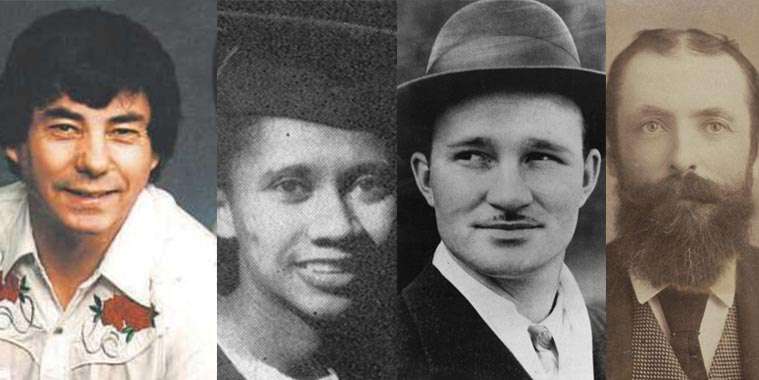This is part two of a series that began earlier this month celebrating ordinary folks from our city’s past who did extraordinary things in their lifetime and helped build the Winnipeg we know and love today.
Len Fairchuk (White Buffalo)
To a generation of Winnipeggers, Len Fairchuck is best known for his television show “The Western Hour” which aired on several local TV stations between 1979 and 1996.
Raised in Horod, Manitoba and the Keeseekoowenin First Nation, Fairchuck first came to prominence as a commercial artist and fiddler. He made headlines in 1959 when he fiddled for more than 48 hours straight in a Portage Avenue electronics store for charity. It was said to be a world record.
Fairchuk spent much of the 1960s and early 1970s in Los Angeles working in the film industry as a special effects artist. Upon returning to Winnipeg, he opened an art shop and got back into the local music scene.
In 1979, he revived a CJOB radio show called “The Western Hour” which originally aired from 1948 to 1962. The combination variety/talent show gave many Indigenous artists, such as himself and Ray St. Germain, their early breaks. This new version would be for television and Fairchuk and his wife, Sandra, travelled the province to record episodes.
Fairchuk died in 2004 at the age of 71. He was inducted posthumously into the Manitoba Aboriginal Music Hall of Fame in 2005.
Frances Atwell
Born Frances Brown in Winnipeg in 1923, Atwell grew up on Charles Street in Winnipeg’s North End and attended Immaculate Conception Church and St. Johns High School.
Growing up in a musical household, Atwell was self taught as a pianist and a singer. She is mentioned numerous times in newspapers articles throughout the 1940s as performing in church concerts, recitals and as a soloist at weddings and other special events. She was also a member of the University of Manitoba Glee Club.
Bernard Safrin, a Euclid Street pharmacist, hired Atwell while she was at school to work part-time in his shop. She later noted, “At the time, the Black presence in any exterior job meeting the public was very unusual.” He encouraged her to enroll in the University of Manitoba’s School of Pharmacy where she graduated from in 1948. She is believed to be the first Black pharmacist in Manitoba.
Atwell’s 60-year career began at St. Boniface Hospital and she would go on to work at the Grace Hospital, St. Norbert Pharmacy and Meadowood Pharmacy. During that time, she also married and raised seven children.
Frances Atwell died on September 20, 2015 at the age of 92.
Ken Leishman
Ken Leishman was a family man living in North Kildonan and working as a kitchenware salesman in the mid-1950s. Thanks to his pilots’ licence, he would fly into rural communities to sell his wares. It turned out that was not the only job he flew to.
Twice in the late 1950s he visited Toronto to rob a bank and was caught after his second heist. His polite manner, dapper dress and flying to “work” earned him the nicknames The Gentleman Bandit and The Flying Bandit.
After his release from jail, Leishman masterminded the heist of 12 bars of gold bouillon from Winnipeg International Airport on March 1, 1966. It remains the largest gold heist in the country’s history. A combination of bungling accomplices and a blizzard led to his capture. He continued to make headlines after a couple of daring jail breaks.
In 1974, Leishman was released and found celebrity status when he was featured in magazine articles and charmed audiences on television shows such as Front Page Challenge.
Leishman and family moved to Red Lake, Ontario in 1977 and opened a tourist shop. In December 1979, he was piloting a medivac flight when his plane crashed. All on board were killed.
Harry Kirk
English-born Harry Kirk arrived at Red River with his wife and children via the Dawson Trail in 1872 and two years later he became one of the City of Winnipeg’s first employees. As “city messenger” he shuttled documents between city employees and to politicians at their day jobs.
When Winnipeg’s first city hall opened two years later, the Kirk family were given a suite inside and his role grew to include caretaker. In 1878, “city bell ringer” was added to Kirk’s duties. He rang it fifteen minutes before school started, at noon, fifteen minutes before store closing time and when the fire brigade needed summoning.
The Kirks moved into the new “gingerbread” city hall when it opened and he tended to the much larger building. He retired as Winnipeg’s longest-serving civic employee in 1898 and died in 1903.
Kirk’s service was even more impressive because of his disability. Soon after arriving in Manitoba he lost most of one hand and the fingers of the other to frostbite. It should have meant a life of unemployment and living off charity. Instead, he became one of the hardest working and most unsung personalities of Winnipeg’s formative years.
Christian writes about local history at his blog, West End Dumplings.



